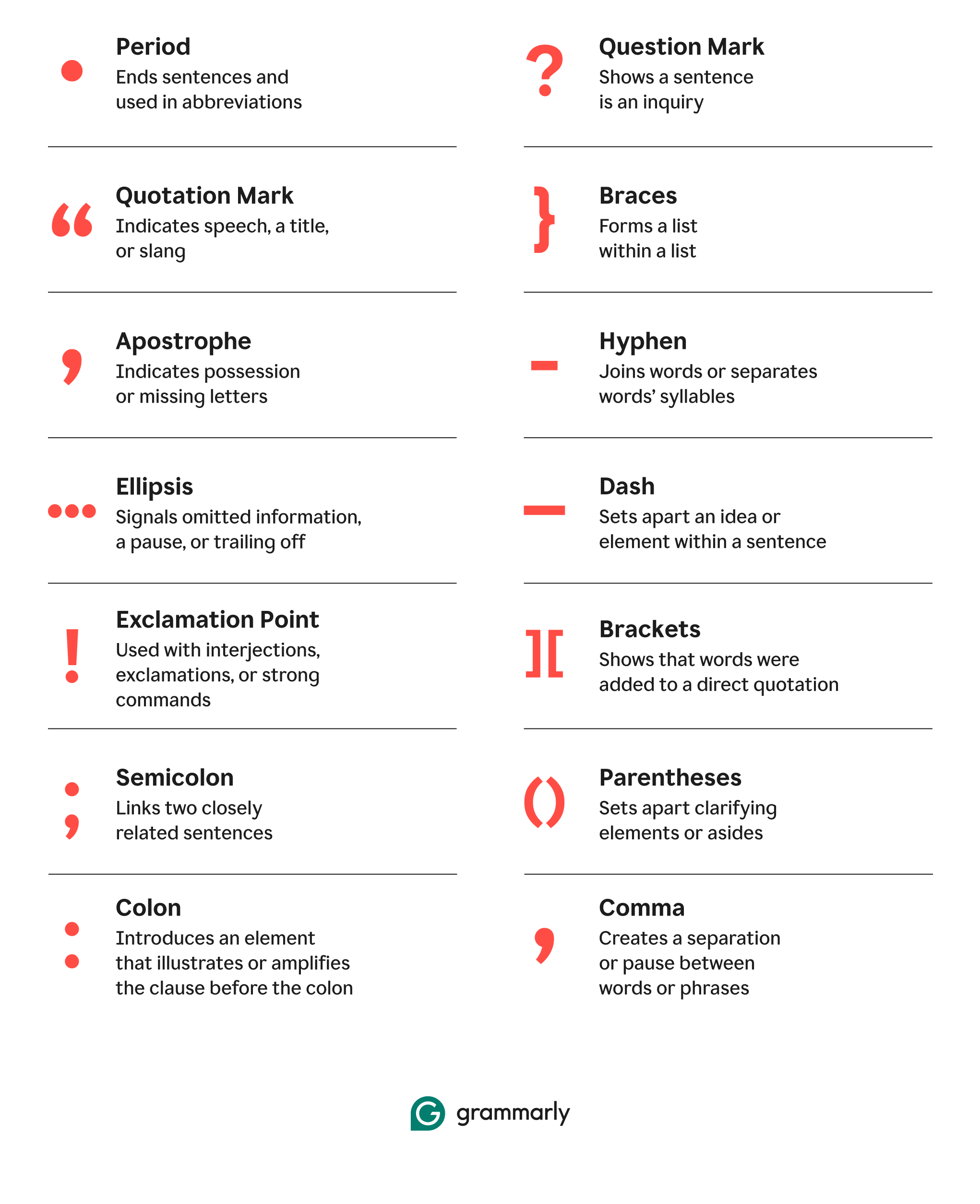Punctuation
Your Guide to Proper Punctuation
Punctuation in English can be complicated—but we can help. Put every comma and period in its place with Grammarly’s AI-powered punctuation checker, or brush up on the basics with our handy resources.


What is punctuation?
Punctuation is a set of symbols that separates and gives meaning to words. It tells readers where to pause, what words are quotations, and more. When you use correct punctuation, you convey your intended message clearly to your audience. Read the resources below to learn all about the 14 punctuation marks and their uses.
Perfect your punctuation
Get AI writing assistance for punctuation, clarity, and more—wherever you write. Grammarly works across 1 million apps and websites so you can get real-time feedback without breaking focus.
Understand the basics of punctuation
This practical guide to punctuation will help you ace apostrophes, perfect parentheses, and excel at exclamation points—so you never have to ask, “Does punctuation go inside quotation marks?” again.

The 14 Punctuation Marks
Punctuation Rules
Common punctuation marks
Explanations and examples to help you become a punctuation mark pro.

Free Punctuation Checker
Polish every sentence with our free, instant grammar and punctuation checker. Paste your text or start typing below to spot punctuation errors.
Frequently asked questions
What is punctuation and what are examples of it?
Punctuation is a series of marks that clarify the meaning of a piece of writing. There are 14 punctuation marks; commas, periods, apostrophes, parentheses, and quotation marks are some of the most commonly used ones.
What are the 14 punctuation marks?
The 14 punctuation marks in English are period (called “full stop” in the UK), question mark, exclamation point, comma, colon, semicolon, dash, hyphen, brackets, braces, parentheses, apostrophe, quotation mark, and ellipsis.
What are the most important punctuation rules?
There are plenty of important punctuation rules, but here are five you should know:
1. All sentences must end in a period, a question mark, an exclamation point, or, if followed by a closely related sentence, a semicolon.
2. Commas and periods always go inside quotation marks in American English; dashes, colons, and semicolons almost always go outside. Question marks and exclamation marks sometimes go inside and sometimes stay outside.
3. Always use quotation marks, brackets, braces, and parentheses in pairs.
Example: They asked, “Is cereal [once you add milk] considered soup?”
4. If an explanatory element is nonessential (i.e., it doesn’t change the meaning of a sentence if you leave it out), set it apart with commas.
Correct: Earth’s oldest tree, Methuselah, is over 4,800 years old.
Incorrect: Earth’s oldest tree Methuselah is over 4,800 years old.
Correct: The inventor Leonardo da Vinci was multitalented.
Incorrect: The inventor, Leonardo da Vinci, was multitalented.
5. Introductory elements can be used at the beginning of a sentence to modify or provide background for the main part of the sentence. Always put a comma after them.
Example: On the long drive home, they concluded the meaning of life is indeed 42.
1. All sentences must end in a period, a question mark, an exclamation point, or, if followed by a closely related sentence, a semicolon.
2. Commas and periods always go inside quotation marks in American English; dashes, colons, and semicolons almost always go outside. Question marks and exclamation marks sometimes go inside and sometimes stay outside.
3. Always use quotation marks, brackets, braces, and parentheses in pairs.
Example: They asked, “Is cereal [once you add milk] considered soup?”
4. If an explanatory element is nonessential (i.e., it doesn’t change the meaning of a sentence if you leave it out), set it apart with commas.
Correct: Earth’s oldest tree, Methuselah, is over 4,800 years old.
Incorrect: Earth’s oldest tree Methuselah is over 4,800 years old.
Correct: The inventor Leonardo da Vinci was multitalented.
Incorrect: The inventor, Leonardo da Vinci, was multitalented.
5. Introductory elements can be used at the beginning of a sentence to modify or provide background for the main part of the sentence. Always put a comma after them.
Example: On the long drive home, they concluded the meaning of life is indeed 42.
How do you punctuate a sentence?
All sentences need punctuation at the end. You can use a period to express a neutral tone, a question mark to show that the sentence is an inquiry, or an exclamation point to indicate excitement or a command. You can also end a sentence with a semicolon if a different, closely related sentence follows that sentence. Here’s an example that shows how each of these punctuation marks work:
Do I like cheese? No, I don’t like cheese. I love it! There are so many kinds of cheese; I never get bored.
Do I like cheese? No, I don’t like cheese. I love it! There are so many kinds of cheese; I never get bored.
How can I use a comma in a sentence?
Commas may be the most varied and versatile punctuation mark in English. Here are the most common ways they’re used, complete with examples:
1. To separate words or elements in a list.
Example: Bats, whales, and goats develop regional accents.
2. After introductory phrases.
Example: Today, I discovered bamboo can grow up to 35 inches in one day.
3. To separate complete sentences joined by a coordinating conjunction (and, but, for, or, nor, so, yet).
Example: Polar bears look white, but their skin is black.
4. To surround elements in the middle of a sentence that are not essential to the sentence’s meaning.
Example: Vanilla, a popular flavoring in desserts, comes from orchids.
5. To separate two or more adjectives describing one noun.
Example: The bright, golden sun shone upon the lawn.
Learn more ways to use commas.
1. To separate words or elements in a list.
Example: Bats, whales, and goats develop regional accents.
2. After introductory phrases.
Example: Today, I discovered bamboo can grow up to 35 inches in one day.
3. To separate complete sentences joined by a coordinating conjunction (and, but, for, or, nor, so, yet).
Example: Polar bears look white, but their skin is black.
4. To surround elements in the middle of a sentence that are not essential to the sentence’s meaning.
Example: Vanilla, a popular flavoring in desserts, comes from orchids.
5. To separate two or more adjectives describing one noun.
Example: The bright, golden sun shone upon the lawn.
Learn more ways to use commas.
How can I improve my punctuation?
Don’t puzzle over tedious grammar rules for hours when you can use our punctuation checker to improve your writing. Ensure your text is clear, compelling, and mistake-free when you use our browser extension and desktop app—available with Grammarly Free.
Better writing starts here
Join the 40 million people and 50,000 organizations who use Grammarly to improve their writing and achieve their goals.